The Burndap Birrarung burndap umarkoo (Yarra Strategic Plan) 2022–32 recognises the Birrarung (Yarra River) as a living and integrated natural entity, it gives effect to the community’s 50 year vision for the river and supports collaborative management of the river and its lands.
The bi-lingual title, ‘Burndap Birrarung burndap umarkoo’, means ‘good for the Yarra is good for all’ in the Woi-wurrung language. This reflects the strong partnership with Traditional Owners in the plan’s development and implementation.
It commits Responsible Public Entities (RPEs), including Melbourne Water, as the Lead Agency, to:
- Manage and protect the Birrarung as one living and integrated natural entity
- Support Traditional Owners as decision makers and partners on their Country
- Work together to improve collaboration along the length of the river for its benefit and protection.
The plan was developed under the Yarra River Protection (Willip-gin Birrarung Murron) Act 2017, which identifies the Yarra River and its surrounding public land as one living and integrated natural entity for protection. It was released by the Minister for Water in February 2022, and its delivery is a Victorian Government commitment to protect our treasured Yarra River, Birrarung, and its parklands for future generations.
Download the Yarra Strategic Plan
Download the full 10-year plan or annual implementation plan:
Developing the plan
The plan was informed by community feedback, background studies, and complementary strategies and policies already in operation for the Birrarung.
An initial step was forming the Yarra Collaboration Committee, with representatives from the 8 local councils and 7 state government agencies with management responsibilities for the river, and the Wurundjeri Woi-wurrung people. We collaborated with the committee to design and implement a four-phase engagement strategy under the banner of ‘Imagine the Yarra’.
This involved:
- Forming the Yarra River Community Assembly to write the vision for the Yarra.
Made up of 24 people from communities along the river, the Assembly took the findings from broad community engagement and drafted the vision that sits at the heart of the plan. - Releasing the draft plan for comment in January 2020.
Feedback was gathered from meetings, pop-up events, focus groups and online engagement reaching more than 120,000 people. This resulted in over 300 conversations and 138 written submissions. - An independent panel process for considering submissions on the draft plan’s land use framework, required under the Act.
The panel, appointed by the Minister for Water, heard submissions in May and June 2020. Their report was provided to the Minister in July 2020:
Yarra Strategic Plan: Panel report - land use framework (1.71 MB, PDF)
Finalising the plan
The Burndap Birrarung burndap umarkoo (Yarra Strategic Plan) was finalised based on feedback from consultation and the recommendations from the independent panel appointed by the Minister for Water.
It was updated to reflect the Victorian Aboriginal Heritage Council’s decision in June 2021 to vary registered Aboriginal party boundaries for Traditional Owners. The actions and land use directions in the plan respect and support both the Wurundjeri Woi-wurrung and Bunurong Traditional Owners to co-manage the river and lands on their Country respectively.
The plan was endorsed by the 8 local councils, 7 state government agencies and 6 committees of management, who collectively have committed to implementing the plan in partnership with the Traditional Owners on their Country. It was then provided to the government for endorsement by the relevant ministers and approved for implementation.
More information on development of the plan and protection of the Birrarung is available on the Department Energy, Environment and Climate Action website.
Further reading
-
Community engagement
-
-
Research and studies
-

